|
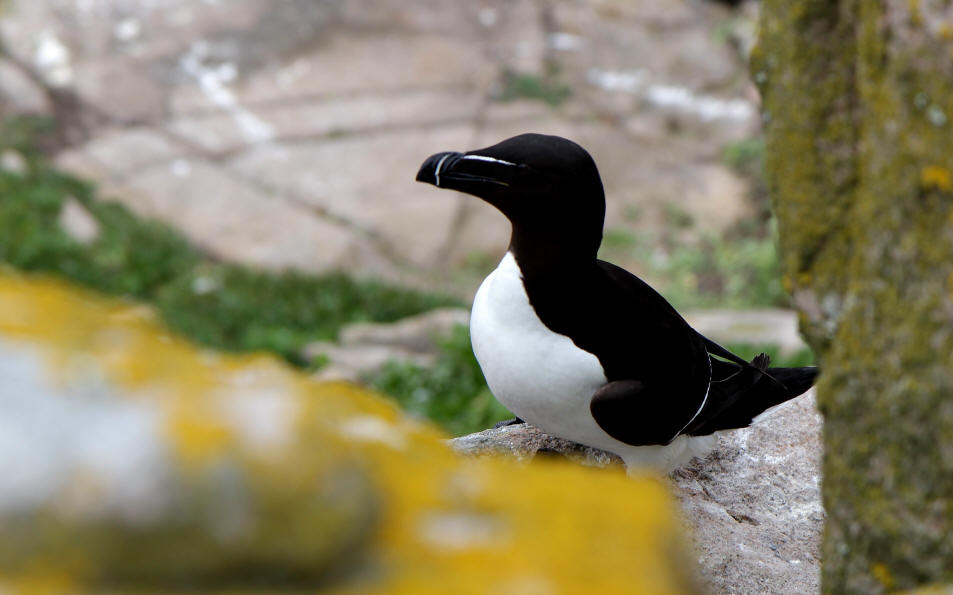
By any standards the Saltee Islands are remarkable, notwithstanding the
fact that there are over 220 species of birds recorded. There are three
main groups of birds on these islands.
- Breeding sea birds
- Resident land birds
- Migrant
birds.
A vast amount of
knowledge of the breeding birds has been gathered over the years by
visiting Ornithologists. The late Prince Michael and the Neale
family have always respected this bird sanctuary and treated
visiting Ornithologists and bird watchers alike with hospitality.
Most day trippers and birds watchers enjoy viewing the Gannets,
Puffins, Guillemots, Razorbills etc.
Great Saltee Bird Maps &
Breeding Status (PDF FILE)
|
GANNET
The Gannets are white birds with
black tipped wings and a long bill. They are both beautiful and graceful
to watch in flight, with a wing span of up to 2 meters. They hunt for
fish by diving from a height into the sea and pursuing their pray under
water. Their eyes are positioned far enough forward to give them
binocular vision allowing them to accurately judge distances.
Gannets can dive from a height
of 30 M, achieving speeds of 100 km/h as they strike the
water, enabling them to catch fish much deeper than most airborne birds.
Gannets are breeders on islands and coasts, they normally
lay one chalky blue egg. It takes five years for gannets to reach
maturity. First-year birds are completely black, and subsequent
sub-adult plumages show increasing amounts of white. Gannets "Jewels of the Saltees" breed
on the island, but are absent during
the winter. |
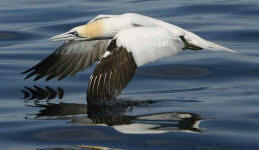 |
|
|
|
|
|
|
|
|
|
|
PUFFIN
Puffins are chunky birds with large bills. They shed the
colourful outer parts of their bills after the mating season, leaving a
smaller and duller beak. Their short wings are adapted for flying under
water. In the air, they beat their wings rapidly (up to 100 times
per
minute) in swift flight, often flying low over the ocean's surface.
Unlike many animals, puffins form
long-term pair bonds. The female lays a single egg, and both parents
incubate the egg and feed the chick. The incubating parent holds the egg
against their brood path with their wings. The chicks fledge at night.
After fledging, the chicks spend the first few years
of their lives at sea, returning to breed after 3 - 6 years.The puffins
are distinct in their ability to hold several (sometimes over a dozen)
small fishes at a time, crosswise in their bill. This allows them to
take longer foraging trips, since they can come back with more energy
for their chick than a bird that can only carry one fish at a time.
Puffins breed on the island, and are in abundance from April to July. |
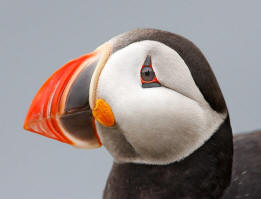 |
| |
|
| |
|
| |
|
| MANX SHEARWATER
Manx Shearwaters are extremely
economical fliers, gliding on wind currents rather than flapping
continuously. It comes to land only during the breeding season, when it
seeks out an island where it can dig a burrow. It will stay at the colony
until the end of the summer and will then head out back to sea where it
travels around southern Atlantic.
The Manx Shearwater has a black back and wings with
a white belly and at about 14 inches long it is slightly larger than a
pigeon. They breed on islands and coastal cliffs in the
North Atlantic. They breed in large colonies and nest in burrows
excavated in soft ground with a chamber at the end. After breeding they
migrate south to places such as South America. They feed on small fish
and shellfish which are captured either on the surface or by diving. They often gather offshore
in large "rafts", this is usually in the afternoon in preparation for
visiting their nest-sites which they always do at night. Manx Shearwaters breed on the island, and are nocturnal.
|
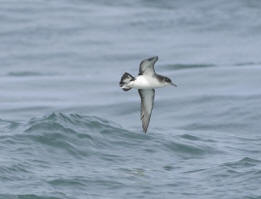 |
| |
|
| |
|
| |
|
|
FULMAR
The Fulmar is similar to the common herring Gull, but on closer
examination one sees the peculiar bill, apparently made up of several
separate pieces. The upper parts are a darker grey than
the
Herring Gull and the wing tips are darker still. In flight the Fulmar is
easily recognised by its long stiff wings which it hardly flaps as it
glides effortlessly about the cliff-face.
Only one egg, completely white
in colour is laid. This is incubated for nearly eight weeks by both
parents taking turns. If the nest is approached both the adults and
young will defend themselves by firing a vile smelling oily
substance at the intruder. It is an inquisitive bird and will
glide within a few feet of an observer to get a closer look. Fulmars
breed on the island, and are present all year round. |
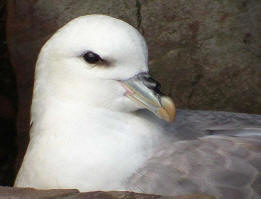 |
| |
|
| |
|
| |
|
| KITTIWAKE
The Kittiwake is so called because of its sounding cry. The gull is only 16 inches long and
has a mild expression unlike the fierce
expressions of the larger gulls. Like other gulls it is white with
grey wings and mantle. Its wing tips are completely black. They construct compact nests of grass and seaweed on tiny ledges on
sheer cliffs of solid rock.
Kittiwakes do no scavenge like other gulls but feed almost entirely
on small fish, crustaceans and platonic invertebrates. They
do this by sitting on the water and catching their prey from the surface
or by plunge diving under the surface. During the breeding season birds will often fly up to 40 miles out to sea in search
for food and will fish both by day and night. They feed their young by
regurgitating when they return to the nest. Kittiwakes breed on the island, and are in abundance from
March to October. |
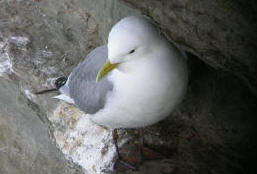 |
| |
|
| |
|
| |
|
| RAZORBILL
Next to the Guillemot Razorbills are the most
numerous cliff nesting seabirds on the Saltee Islands. The are
smaller than the Guillemot. The head and upper parts are black and
the under parts are white. Their bills are very distinctive there
is a white vertical line in the middle and a thin white line runs from
the base of the bill to the eye. Razorbills have short wings which
they flap rapidly in flight.
They nest on cliff ledges or boulders. They stand up right like penguins and
waddle rather clumsily. They often dive in groups. They are
expert divers and propel themselves under water with both their wings and
webbed feet. When feeding their young they are able to hold several fish
together in their bills. Razorbills breed on the island, and are in abundance from
March to October. scared off their ledges, eggs roll off
and are broken, others are taken by gulls while unattended. Guillemots breed on the island, and are in
abundance from March to late July. |
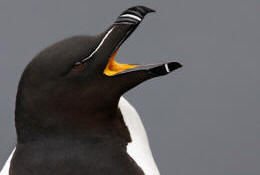 |
|
|
|
|
|
|
|
|
|
| GUILLEMOT
The Guillemot is larger than the Razorbill, though
slimmer and longer necked. The head, neck and upper parts of the
body are dark brown, while the under parts are white. The
guillemot also
has small wings and stands penguin like when
perched on ledges and rocks. When not on their breeding sites the
Guillemots spends most of its time at sea swimming about and diving for
small fish.
They make no nests but
simply deposit their single pear shaped egg on the bare rock. Losses of
eggs are heavy, especially when disturbed by humans.
|
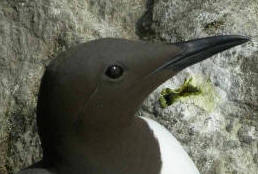 |
| |
|
| |
|
| |
|
| GREAT BLACK BACKED GULL
Great Black backed
Gulls are the lords of the seabird colonies. They choose the highest
vantage points to build their nests. The adults are unmistakable because of their size, jet
black wings and mantle, measuring two and a half feet with a five foot
wingspan.
The massive bill is yellow with an
orange spot on the lower mandible. If an intruder
approaches the parents call anxiously and the young
birds "freeze" in the dense cover and are hard to
locate. The parents also will also make low swoops at
the intruders head, however they seldom strike. Great
Black backed Gulls breed on the island, and are in
abundance all year. |
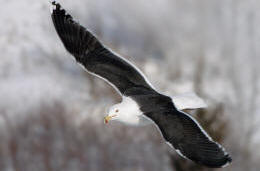 |
| |
|
|
|
Top of Page |
|
|
|
|